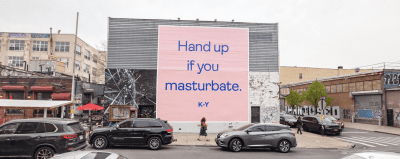Your Next Great Weekend Getaway: Scribner’s Catskill Lodge
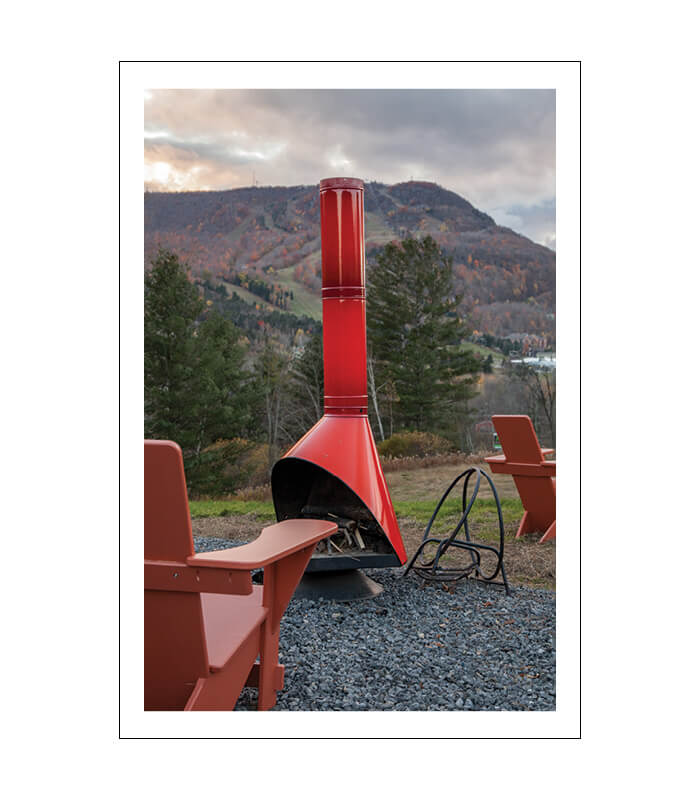
When I was in high school, my uncle organized a family reunion for my grandparents’ 50th anniversary at the Nevele in the Catskills. It was one of the last of the old Borscht Belt resorts to survive after Grossinger’s—the place that inspired Dirty Dancing—was long abandoned and left to decay. (The Nevele closed in 2009.) Though I was far less traveled than I am now, I remember finding the place utterly and hopelessly dated. Mostly I remember mossy old carpets and the odd feeling of being stuck in a time warp. It seemed like we were the only guests at the massive resort.
Scribner’s Catskill Lodge was in a similarly dreary state when owners Glennon Travis—a veteran of the hospitality industry who most recently managed Soho House—and Marc Chodock—a management consultant—got their hands on it. Originally built in 1966 by an eccentric painter from Brooklyn, the property (then known as Scribner’s Hollow Motor Lodge) was neglected by subsequent generations. “Everything was salmon brown and mustard yellow. The last time they changed the carpets was in the 1980s,” Travis told me when I made the trek up to Hunter for a preview of the new Scribner’s. “It was a weird place to begin with and then stuck in time. And that’s what we loved about it. It needed a breath of fresh life.”
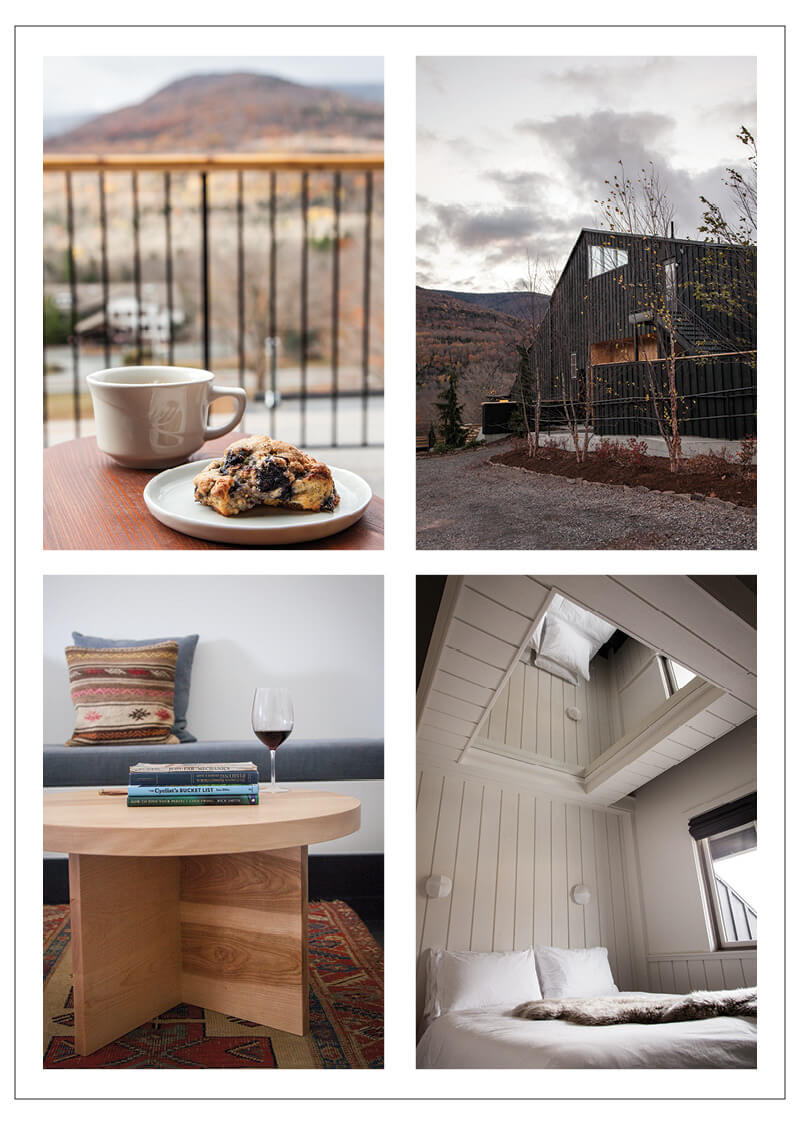

We were sitting in one of the renovated rooms, which—though incomplete—showed the place’s incredible potential. Before Travis arrived, the hotel’s creative director Sarah Simon picked me up from the Hudson train station in an old red Jeep, drove me up the mountain past Kaaterskill Falls, and gave me a tour of the property. I was one of the first journalists to get a preview, and just a few weeks away from the opening date, their excitement for the project was palpable.
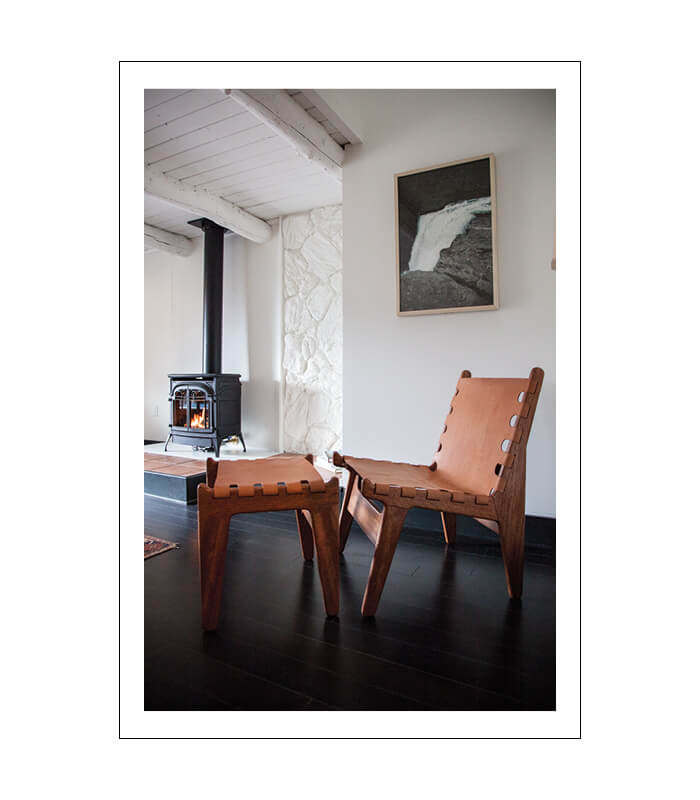

SPACIO TERRENO
Run by husband-and-wife team Patricio Andrade and Isabel Becerra de Andrade, who both studied at Pratt, Spacio Terreno is responsible for the modern-rustic seating in Scribner’s. Inspired by South American silhouettes, minimal design, and heirloom furniture, they designed and prototyped the Fumador chairs and ottomans in their Sunset Park studio and had them handcrafted in Ecuador. The leather is vegetable tanned and attached to a frame of solid Seique wood grown in the Amazon. The family that does the leather cutting is a group of fifth generation saddle-makers. “It opened up a new industry for them, which is great,” Patricio said. “It worked out for everybody.” The made-to-order chairs, ottomans, and other home design items are available on their website, spacioterreno.com.
Two-and-a-half years in the making, Scribner’s was born out of Travis and Chodock’s desire to escape the city with its oppressively crowded subways and scene-y nightlife. Travis, who untilrecently lived in DUMBO with his wife and three-year-old son, recalled, “I just had this moment on the rooftop at Soho House two summers ago where the place was going off and it was packed with models and celebrities and everyone was drowning themselves with rosé. When I was 25, I would kill to be a part of that, and at the age of 35, I was like, I just don’t care about this anymore.”
He and Chodock felt the Catskills, with their fresh air and beautiful scenery, were calling. Other places where New Yorkers often go on the weekends, like the Hamptons and Jersey Shore, just didn’t speak to them the same way the Catskills did. They began searching for a hotel to buy and eventually found Scribner’s, with its postmodern A-frame architecture built right into the side of a mountain. They teamed up with DUMBO-based Studio Tack, a small design and development group run by three Columbia GSAPP grads and the former brand director at Ace Hotels, and the guys behind Greenpoint restaurant Esme, who consulted on food and beverage development.


ESME
“It’s so weird talking about it, but the original Michelin star program was about how many stars is worth it to drive to the location,” Travis said. “And this food is gonna attract a lot of people to drive here.” With this idea of a destination restaurant in mind, Travis and Chodock consulted with Matthew Ricke and chef Adam Volk, two of the three partners at Esme, a neighborhood bistro in Greenpoint that serves creative riffs on American classics. The team devised an Alpine-inspired food and beverage program that takes advantage of local farms, breweries, and distilleries. Now that Prospect is up and running, chef Joseph Buenconsejo has taken the helm in the kitchen.
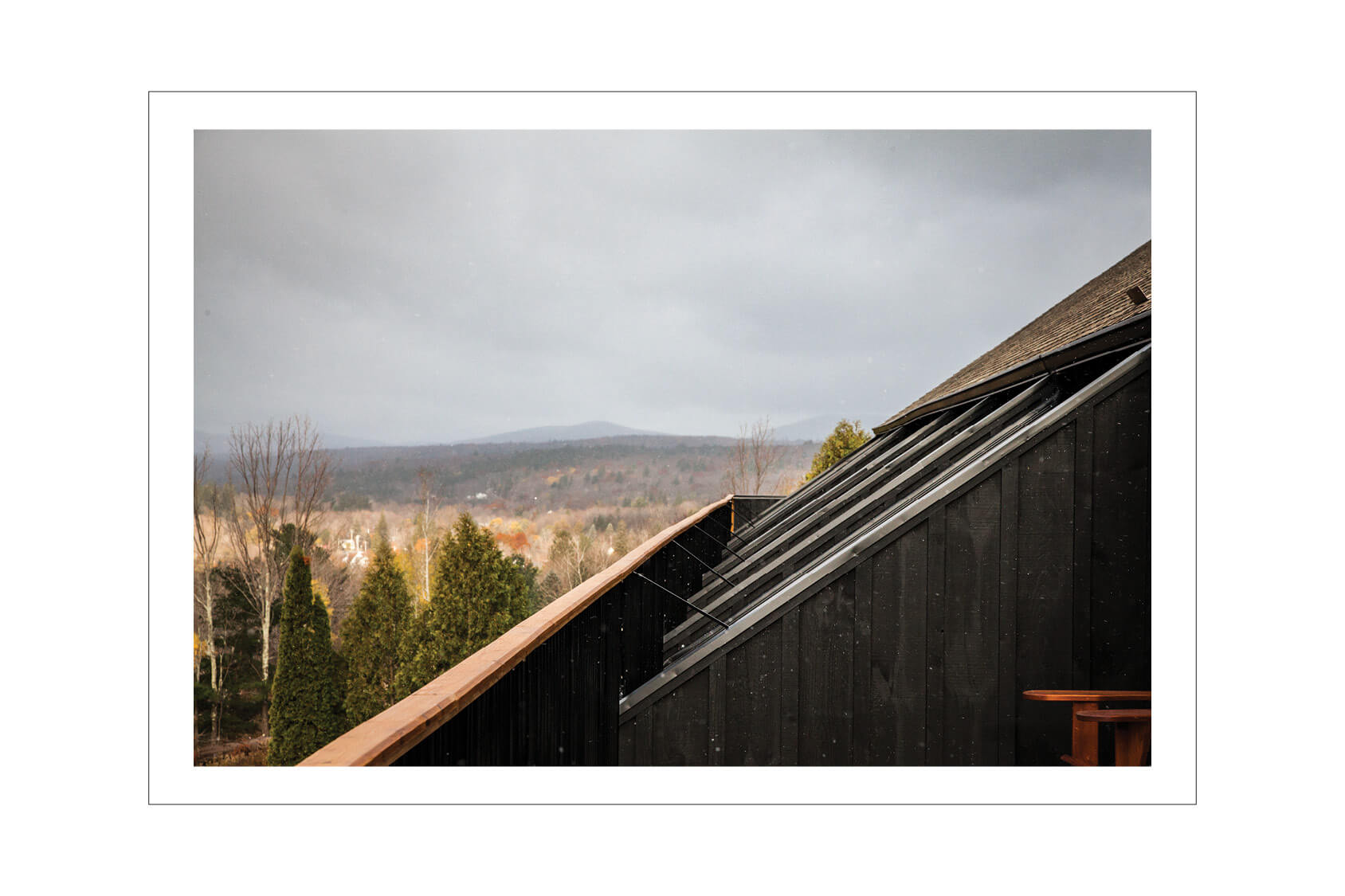

Inspired by Alpine mountain lodges, Studio Tack came up with a bright, airy design layered with an eclectic mix of colors and textures—brick, stone, wood, Indian dhurries, Oriental rugs, Frette linens, and custom leather chairs by Sunset Park-based design workshop Spacio Terreno. White-washed rooms display photos by Emily Johnston, who splits her time between Brooklyn and the Catskills, and hand-loomed fiber art by the Catskill Kiwi. Each of the 38 rooms has its own character—some have gas stoves, sunken seating areas, or lofted bed nooks. Most have their own balcony complete with a modern interpretation of the Adirondack chair, ideal for taking in the sweeping views of the landscape. The overall vibe is a cozy country escape with the cool, laid-back style you find at your most grown-up friend’s apartment. Plus, Scribner’s aims to encourage a social atmosphere with inviting communal spaces, from the library with its fireplace to the Whiskey Lounge and Prospect restaurant. “It’s a place where the fashion crowd from New York City can come up and let their beard grow and their hair down and eat BBQ with their hands,” Travis mused. “We’re hoping that people will embrace that and escape from the city for a little bit.”
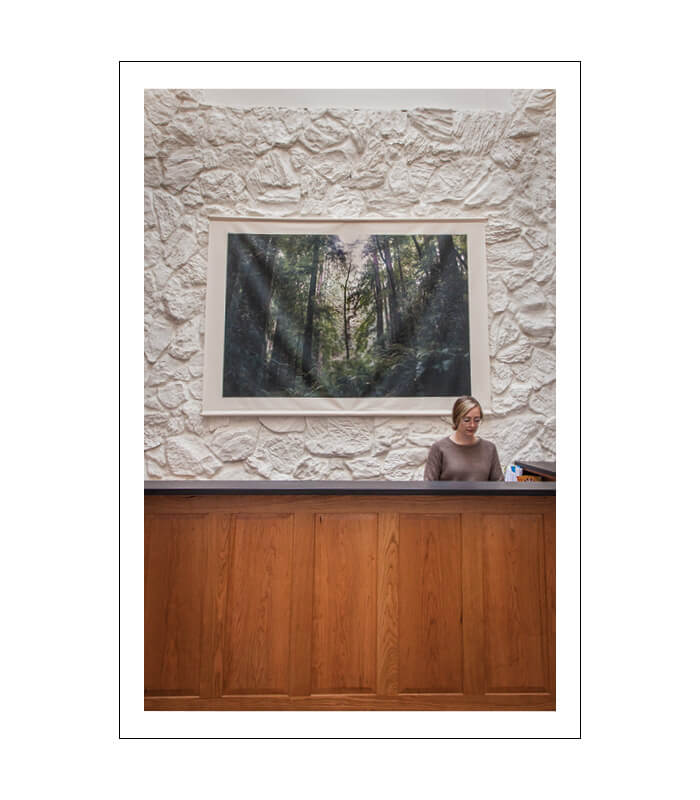

When she’s not traveling the world, photographer Emily Johnston splits her time between the East Village and the Catskills, where she shot a series of images that hang in Scribner’s rooms and public spaces. “When we connected they didn’t know I lived up here part time, so we were all quite excited when I was able to share a collection of images that I had been photographing in the area,” she said. Her striking photos of the trees and mountains bring the verdant landscapes to life, forming the perfect compliment to the hotel’s design. Most of her work belongs to private collections, though she’s currently working on a book of photographs and drawings set to be announced in 2018.
About 100 miles northwest of New York City, the Catskills are conveniently close but a bit of an unknown. Bordered by the Hudson River on the east, the massive region encompasses nearly 6,000 square miles. And unlike in Hudson—a very walkable city easily accessible by Amtrak—you need a car to explore the Catskills. As an escape from the city, it’s not exactly a new destination. Well-to-do New Yorkers used to travel up the river by steamboat in the 1800s to get away from the city and enjoy the scenery. Scribner’s is actually on the site ofone of the grand old Gilded Age hotels, known at the time as the Catskill Prospect House. In its heyday, it could sleep 200.
The area began to suffer when steamboat travel went out of fashion in the 1900s, but enjoyed a new wave of interest starting in the 1920s when it became known as the Borscht Belt for the many summer resorts and bungalow colonies that catered to New York Jews—including my grandparents—who found leisure and refuge there at a time when they were often discriminated against. “When we went there it was alive, it was active, and all the hotels were bustling,” my grandmother recounted. A lot of comedians, actors, and singers got their start at the resorts, which organized entertainment for the guests. There was a very social element to these places. “You actually made friends, and if they lived near you, you saw them again,” my grandmother remembered. “We used to take pails or buckets into the woods and pick berries and come back with buckets of blueberries or strawberries or blackberries and make our own pies.” They used to go into town for ice cream sodas, to shop, or go to the movies—small town pleasures you can still partake in today. In the late 60s and 70s, many of the old Borscht Belt resorts went out of business, leading to an economic decline. Lots of them—including Grossinger’s—were left to rot and have since become a curiosity for urban explorers, who break in to photograph the ruins.

Like the old resorts, Scribner’s aims to be a destination in and of itself, with a host of activities on the property, and an adventure concierge (formerly concierge at the Standard High Line), who can guide guests to the best hikes, farms, breweries, distilleries, and other things to do in the area. “We are trying to be a full service resort, so we’ll have fitness on property, we’ll have music, local DJs, we’re talking about doing a vinyl-only night,” Simon explained. “We’re also going to be doing cider tasting and I’m hoping soap making and candle making.” And just like my grandmother used to go into the woods to pick berries, guests at Scribner’s can go foraging with the chef, Joseph Buenconsejo, the former executive chef at Wassail on the Lower East Side. His menu for Prospect emphasizes sharing, with small plates and family-style dishes like a whole roasted chicken, grain risotto, and pork jowl schnitzel.
To pair with the food, bar manager Michael King has scouted out the best craft beers from New York state, curated an approachable wine list, and developed cocktails using spirits from craft distilleries like Hudson Valley Distillery and Union Grove Distillery. He’ll teach guests to make craft cocktails with local maple syrup and other seasonal ingredients.
Sitting in the unfinished room, Travis reflected on the area’s revitalization, affirming that it’s being led by people from Brooklyn—mostly in the hospitality industry. “It’s that Brooklyn vibe of authenticity, craftsmanship, and the kind of rejection of big box hotels, big box restaurants.” He hopes Scribner’s will be an escape for the young, creative people from New York who can’t necessarily take a two-week vacation, but want to get out of the city on the weekends. “You hop on the thruway or Amtrak and two hours from midtown Manhattan you feel like you’re a million miles away, looking out over these dramatic peaks, seeing the trees change color, in the wintertime you see the snow, and in the springtime you see all the animals. You’re totally transported. It’s a different world out here. But you can still pop back Monday morning and be behind your desk by 9 am.”
After the tour, I got a glimpse at the area’s renaissance in nearby Tannersville when Simon and I stopped for lunch at Mama’s Boy Burgers, a cute retro burger and ice cream stand that serves local grass-fed beef from a farm a mile-and-a-half away and ice cream made in the Hudson Valley. She told me the owner was working on a pizza place nearby thanks to assistance from the Hunter Foundation, a non-profit aimed at promoting economic development and tourism in the area. Downtown Tannersville still looks much the same as it did in the 50s when my grandmother used to visit the Catskills. The day I was there, the main street was blocked off for a classic car show and Hunter Mountain was hosting Oktoberfest. There are also several other inns and restaurants in the area, including the Arnold House and the remodeled Phoenicia Diner. People coming to experience the region’s natural beauty and hike around the waterfalls will find plenty to do. As Sarah drove me back down the mountain, I made a mental list of all the things I still need to go back for, and explore on subsequent trips.
STUDIO TACK
A small design and branding firm based in DUMBO, Studio Tack is making its mark on the hospitality industry, and collaborating with local artisans is a key part of their modus operandi. Their work is turning heads from Barcelona, where they designed the über-cool Casa Bonay, to South Lake Tahoe, where they created the Coachman. “They’ve carved out a niche in the design world focusing on renovations of mid-century hotels that have tons of character, but may have suffered from neglect,” Travis and Chodock agreed. “We love what they did at the Coachman in Lake Tahoe. Plus they’re a great group of people to work with.” Brentwood—the first hotel they designed, own, and operate—is now taking reservations for stays in Saratoga Springs.
MORE PLACES TO STAY IN THE CATSKILLS
Husband-and-wife team Sims and Kirsten Foster own and operate a trio of inns and have made it their mission to revitalize the Catskills. Nestled at the base of Shandalee Mountain, The Arnold House offers great design and a convivial atmosphere, with meals in the tavern and bonfires outside. Their 9-room North Branch Inn in Sullivan County has a restored turn-of-the-century bowling alley and a movie screening room with red velvet chairs from Rockefeller Center. Their newest hotel, 9 River Road, has just eight rooms in a former furniture store built in 1884. ♦
Photos by Jane Bruce
You might also like 
















